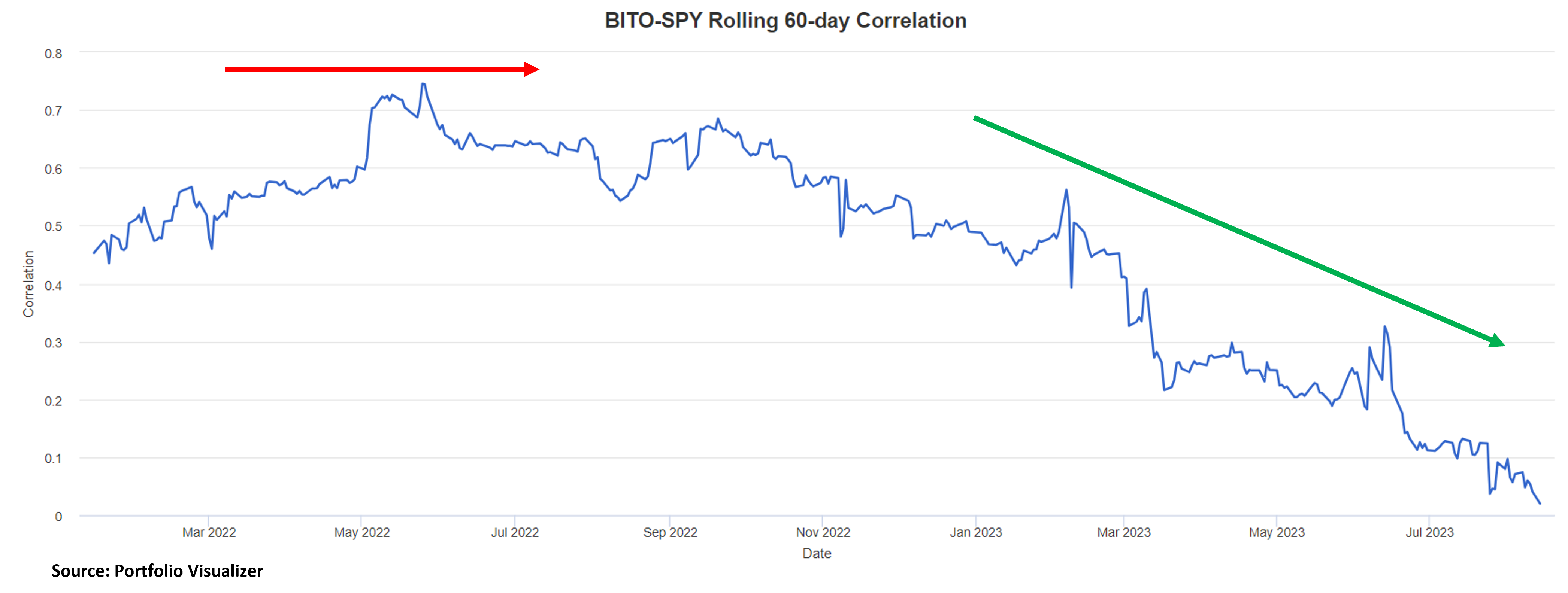
Kanchanara courtesy of Unsplash.
Bitcoin Correlation to the S&P Through the Years
Investors are looking at Bitcoin as an alternative investment for diversifying their portfolios. Alternative investments often exhibit high volatility and a low correlation to traditional equity and fixed income markets. Along with Bitcoin’s volatility and low correlation comes outperformance.
Investing in Bitcoin loses some of its luster if the low correlation to traditional equity markets does not hold. The historical correlation of Bitcoin to the S&P 500 over the last 10 years is 0.17. This is lower than other alternative asset investments over the same period. For example, the S&P Goldman Sachs Commodity Index has a correlation of 0.42 to the S&P 500 over the last 10 years. More examples of alternative investments and their correlation to stocks are listed below along with annualized returns over the last 10 years.
|
Investment (as of 7/31/2023) |
10 Year Correlation to S&P 500 |
10 Year Annualized Return |
|
Bitcoin |
0.17 |
75.37% |
|
S&P GS Commodity Index |
0.42 |
-3.00% |
|
HFRX Global Hedge Fund Index |
0.78 |
1.45% |
|
Wilshire REIT Index |
0.72 |
6.62% |
(Data obtained from Morningstar and eVestment)
The long-term historical correlation of Bitcoin to the stock market has been very low as demonstrated above, but this number has been increasing somewhat in recent years. If the time period is reduced to the last 5 years, the correlation of Bitcoin to the S&P 500 is increased to 0.41. This is still lower than the other alternative investment asset classes listed above, but the trend of increasing correlation over time prior to this year has been concerning.
In 2023, however, the correlation between Bitcoin and the S&P 500 is beginning to trend back towards its longer-term average. This is represented in the following chart: This chart shows shorter-term rolling daily correlations between the Proshares Bitcoin ETF (BITO) and the SPDR S&P 500 ETF (SPY).
The red arrow above shows when the rolling 60-day correlation of daily returns between BITO and SPY hit its peak, around 0.75. Since then, it has been a steady downward trend, especially once 2023 started, which you can see represented by the green arrow above. The correlation has dropped almost to 0.0 since the beginning of the year. For a while it seemed that more mainstream attention and widespread adoption of Bitcoin was going to morph it into yet another risk-on asset that moved with the equity markets, but as we move through 2023 it has been encouraging to see Bitcoin decouple from the stock market. If Bitcoin can provide low correlation to traditional asset classes, then it should be able to become a more serious contender for inclusion within institutional investor portfolios.
Contact us to learn about iSectors® CryptoBlock® Allocation Model. The iSectors® CryptoBlock® Allocation is a uniquely-positioned investment model designed to give advisors and their clients the opportunity to take advantage of the continuous and rapid adoption of cryptocurrencies and the underlying evolution of the technology that makes them possible: blockchain technology. Cryptocurrencies and blockchain technology investing can present advisors with some distinct compliance and reporting challenges. The iSectors® CryptoBlock® Allocation’s investment strategy aims to simplify the regulatory, transaction, and performance reporting by accessing cryptocurrencies, and companies implementing blockchain technology through widely available, liquid, and transparent ETFs and/or publicly-traded investment trusts.


